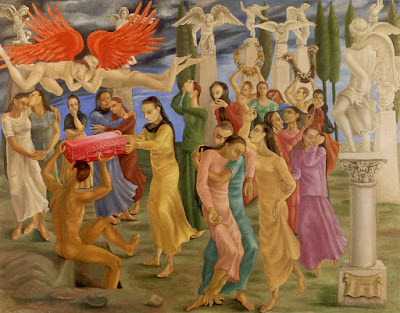Juan Soriano (1920 -2006) was born in Guadalajara to a middle-class family. His father, Rafael Rodríguez Soriano, fought in the Mexican Revolution, later becoming a minor politician and, eventually, a spiritist. His mother, Amalia Montoya, who had followed her husband into battle as a "soldadera," or female soldier, kept the house that included Juan's thirteen aunts and four sisters. His precocious talents led him to enter the circle of the renowned artist Jesús Reyes Ferreira, known as "Chucho" Reyes, who introduced Soriano to pre-Columbian and colonial Mexican art as well as art from outside his country. Soriano began exhibiting in Guadalajara at age 14. His first show in the regional museum attracted the attention of such influential Mexican painters as María Izquierdo and José Chávez Morado as well as the photographer Lola Álvarez Bravo, all of whom became close friends of Soriano and urged the young man to travel to Mexico City. The following year (1935), Soriano moved to the Mexican capital and soon entered into a lively visual and personal dialogue with Rivera, Frida Kahlo, Orozco, Siqueiros, as well as the more vanguard artists and writers who composed the famous Contemporáneos group.
Soriano considered the work of all these diverse artists with care, drawing on a deep interest in popular and indigenous arts, as well as the expressive modes derived from Cubism, German Expressionism, and Fauvism as well as the School of Paris artists of the interwar period. In addition, he became acquainted with the imaginative forms of painting that were behind the creations of the European Surrealists who had come as war refugees to Mexico at the end of the 1930s and into the 1940s.
While all of these elements are at play in Soriano's unique works done during these two decades, he cannot be directly connected with any one trend, creating a personal brand of romantic realism. Soriano was also in contact with the most distinguished art dealer of the time, Inés Amor (of the prestigious Galería de Arte Mexicano), who was instrumental in placing Soriano's works in important local and foreign (especially American) collections, and had a pivotal role in the acquisition of Philadelphia's four Soriano paintings (the most extensive collection of works by the artist in the United States).
After 1950, Soriano began several long periods of residence outside Mexico. He experimented with various approaches to abstraction in both painting and sculpture, and also expanded his frame of artistic reference and did extensive set and costume work for the Mexican theatre company "Poesía en Voz Alta." His years spent in Rome and later in Paris definitively changed his art as he absorbed what his life-long friend Rufino Tamayo would call "universalist tendencies."(juansoriano.net)










No comments:
Post a Comment